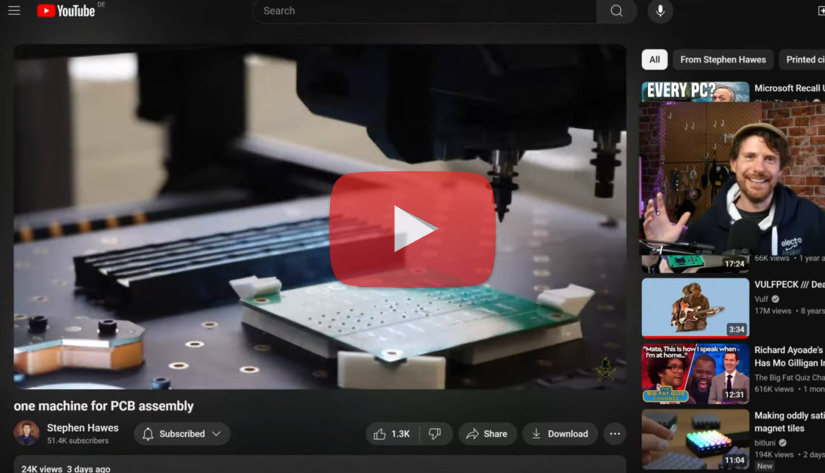Revolutionizing SMT Soldering with Conductive Ink and Lumen Pick-and-Place
Steven Hawes has taken an innovative approach to simplify surface-mount technology (SMT) soldering by experimenting with conductive ink instead of traditional solder paste. While not intended to replace solder paste entirely, his work offers an exciting glimpse into how electronics prototyping can be done faster and more efficiently without relying on heat, hot plates, or solder masks.

Watch Ian talk about Stephen Hawes' Solderless PnP follow up in this episode of The Electromaker Show
In his experiments, Steven explored a variety of materials and methods to avoid the usual soldering process, eventually settling on conductive ink as a viable alternative. By applying the ink and using a pick-and-place machine to position components, he achieved a streamlined workflow that reduces the complexity of traditional SMT soldering.
Central to his process is the Lumen Pick-and-Place (P&P) machine, an open-source, affordable tool designed for precise component placement. The Lumen P&P allows for easy integration of new techniques like Steven’s conductive ink process, opening up new possibilities for rapid prototyping in electronics.
How the Lumen Pick-and-Place Machine Works with Conductive Ink
Steven Hawes’ experiment with conductive ink and the Lumen Pick-and-Place (P&P) machine showcases a new, efficient method for prototyping electronics. By combining the precision of the Lumen P&P machine with the quick-setting properties of conductive ink, he was able to place surface-mount components without the need for heat or solder paste.
The Lumen P&P machine precisely places components onto the board while the conductive ink holds everything in place. As the components are positioned, LEDs light up, powered by the conductive ink, visually confirming that everything is correctly connected. This innovative approach significantly reduces the setup time required for traditional SMT soldering.
Steven experimented with several designs before finalizing this process, ultimately creating a method that is not only functional but also highly efficient. The Lumen P&P machine’s open-source design and affordability, priced under $2,000, make it accessible to both hobbyists and professionals, allowing anyone to explore new ways to prototype electronics quickly and effectively.
Innovations and Python Control for the Lumen P&P Machine
One of the most exciting aspects of Steven’s work with the Lumen Pick-and-Place (P&P) machine is his development of Python libraries that bring a new level of control and customization to this already versatile tool. These libraries allow users to control the machine in ways that go beyond the capabilities of traditional commercial pick-and-place machines, making it more adaptable for different use cases.
By writing Python code, Steven has opened up a world of possibilities for makers, allowing them to adjust how the machine operates and even incorporate additional hardware. This level of control is particularly useful for rapid prototyping, as it enables users to tweak and optimize the machine’s functions on the fly.
At its core, the Lumen P&P machine is a precise, programmable robotic arm capable of handling delicate components with accuracy. Priced under $2,000, it is one of the most affordable pick-and-place machines available. With Steven’s Python libraries, the machine can now be further customized, allowing hardware hackers to experiment with new functionalities by adding different tools or sensors to the robotic arm.
Did you enjoy this article?
Make sure you subscribe to The Electromaker Show for similar content and subscribe to our monthly newsletter!














































Leave your feedback...